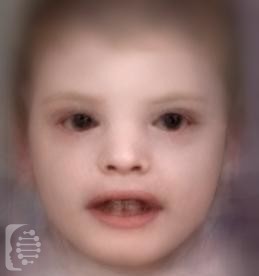What is Ablepharon-Macrostomia syndrome?
Ablepharon-Macrostomia syndrome is a rare genetic condition.
Symptoms of the syndrome largely affect the head and face but can also affect the skin, fingers, and genitals.
The unique facial features of the syndrome are one of its main identifying symptoms.
This syndrome is also known as:
Ams McCarthy syndrome
What gene change causes Ablepharon-Macrostomia syndrome?
The syndrome is caused by mutations in the TWIST2 gene. It is inherited in an autosomal dominant pattern.
In the case of autosomal dominant inheritance, just one parent is the carrier of the gene mutation, and they have a 50% chance of passing it onto each of their children. Syndromes inherited in an autosomal dominant inheritance are caused by just one copy of the gene mutation.
What are the main symptoms of Ablepharon-Macrostomia syndrome?
Symptoms mainly affect the head and face but also the skin, fingers, and genitals.
The unique facial features of the condition include missing or under-developed eyelids, as well as missing eyelashes and eyebrows. A very wide mouth and under-developed ears are also common to the syndrome. A triangular face, a small misshapen nose, and thin hair may also be present.
Other features may include webbed fingers, thin skin with folds, intestinal hernias, and genital abnormalities including underdeveloped nipples and testes.
Possible clinical traits/features:
Umbilical hernia, Ventral hernia, Abnormal hair quantity, Camptodactyly of finger, Delayed speech and language development, Visual impairment, Depressed nasal bridge, Hypoplasia of penis, Underdeveloped nasal alae, Hypoplasia of the zygomatic bone, Opacification of the corneal stroma, Hearing impairment, Cognitive impairment, Myopia, Anteverted nares, Neurological speech impairment, Microdontia, third degree microtia, Ablepharon, Abnormality of female external genitalia, Abnormal nasal morphology, Absent eyebrow, Ambiguous genitalia, Abnormality of the mouth, Abnormality of skin pigmentation, Abnormal eyelash morphology, Aplasia/Hypoplasia of the nipples, Aplasia/Hypoplasia of the eyebrow, Breast aplasia, Autosomal recessive inheritance, Thin skin, Thin vermilion border, Wide mouth, Toe syndactyly, Omphalocele, Fine hair, Atresia of the external auditory canal, Absent eyelashes, Cryptorchidism, Cutis laxa, Cryptophthalmos, Corneal erosion, Dry skin.
How is Ablepharon-Macrostomia syndrome diagnosed?
To find out if someone has a diagnosis of Ablefaron-Macrostomia syndrome, it is important to have a consultation and evaluation with a clinical genetic specialist. Specialists may also suggest specific genetic testing or other types of tests to help reach a diagnosis. FDNA’s AI technology can help speed up the diagnostic process by analyzing facial features and other health information.

